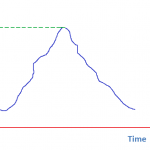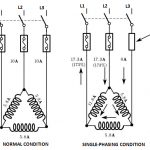Effects of low power factor on the power system and its equipment like, the low power factor means a larger size of Generating plant and Transmission & Distribution equipment.
If the loads are operating with low power factor then there are many disadvantages like increased cost of equipment, and system losses also increased.
First of all, we are going to discuss, how the Low power factor affects the size of an alternator.
Effects of Low Power Factor on Size of Alternator:
Let us see, how the size of an alternator increased with a decrease in operating power factor.
Consider a single-phase alternator shown in the below figure.

From the above Nameplate details
KVA Rating of Alternator= 10KVA
Voltage rating V=240V
Now see the operation of the Alternator at various power factors.
Operation of Alternator at Various Power factors:
1.At Unity Power Factor:
If this alternator operates at a Unity Power factor
Then KW= KVA* PF
KW=10*1=10 KW
We know that
P=VICosØ
I=P/VCosØ
Full load current at UPF I=10*1000/240*1=41.66A
2. At 0.8 Power factor:
If this alternator operates at a 0.8 Power factor
KW= KVA* PF
KW=10*0.8=8 KW
- Thus alternator is only supplying 80% of its full load capacity (10KW) although the alternator is fully loaded. Hence alternator size needs to increase to supply 10KW.
At 0.8 Power factor, to produce 10KW the alternator current is
I=P/VCosØ
Full load current at 0.8 PF I=10*1000/240*0.8=52.08A
- It means now the alternator is overloaded by 20% of its full load current rating (41.66A). Hence winding losses also increased.
Calculation of Size of the Alternator:
Now see how the size of the alternator increase with a decrease in power factor.
For 10KW output, the size of the alternator is calculated as shown below.
Alternator KVA=KW/POWER FACTOR
KVA=10/Power FACTOR
At Various Power factors, the Alternator Size is as Follows:
| Power factor | KVA |
| 1 | 10.00 |
| 0.8 | 12.50 |
| 0.6 | 16.66 |
- From the above results, the KVA rating of the alternator increases with decreasing Power factors.
Relation between KVA and Size of an Alternator:

From the above expression, it is observed that for increased KVA ratings the rotor diameter and length increased and hence the size of the alternator increased.
The following points are valid from the above discussion.
- For lower power factors the alternator would be overloaded with higher load currents.
- For lower power factors the alternator would be made of much larger cross section and hence size of alternator increased.
- Size of the alternator is decided by the KVA output not by kW.
Effects of Low Power factor on Various Equipments:
We all well known that,
The load current for a three-phase balanced system is derived from the below expression.
IL= (PL /√3V cosØ)
PL = Load power
IL = Load current
V = Terminal voltage
CosØ = Power factor
From the expression of load current, we can observe that if the power factor is low then obviously load current is high.
- Size of Equipment Increased:
As discussed above the size of Equipment like generators and transformers increased since for low power factor loads load current IL is more and hence KVA/MVA rating increased to deliver the same amount of real power PL
- Winding losses Increased:
If any equipment continuously operated with a lower power factor the winding losses increased.
IL= (PL /√3V CosØ)
If PL and voltage are constant load current is inversely proportional to the power factor, and hence if the power factor is low then load current is large.
As discussed above the load current is increased by 20% for a 0.8 Power factor.
- Cost of Generation and Transmission Increased:
As more copper is required to deliver power at low power factors
For example; for a 3-phase 3-wire system
The volume of conductor material required is K/ cos2Ø
Since the volume of the conductor is inversely proportional to the square of the power factor and if the power factor is low, volume and hence copper requirement is increased.
- Poor Voltage Regulation: Large voltage drops/ IR drops causes poor voltage regulation. To cope up this additional voltage regulating equipment is needed.
- Power Tariff Increased: If any Industries operate their loads at low power factor then fines imposed by power distribution companies and forced to install power factor correction equipment.
- Cost of Phase advancing equipment increased.
Effects of Low Power Factor & Various Operating Loads:
- Induction Motors usually operate at low power factor. It falls further if the load is decreased.
- Agriculture motor pump sets operate with very lagging power factors.
- Arc and Induction furnaces, Welding Machines.
- Arc Lamps, High intensity discharge Lighting, Lighting Ballasts etc.
Low Power Factor Correction:
Low power factor correction is a method of improving the power factor and therefore, improving the power quality.
The low power factor can be corrected using
1. Capacitor banks
2. Synchronous Condenser
3. Phase Advancers used to improve the power factor of induction motors.



